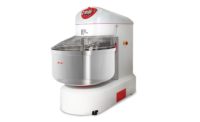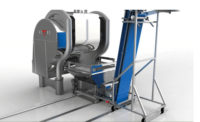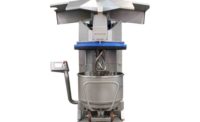Snack and bakery manufacturers have a range of parameters in mind when they’re in the market for new or improved dough mixers. High on the list are greater cost control, energy savings, worker safety, sanitation, consistency, solidly reinforced construction, connectivity to the “internet of things” and the ability to customize operation to accommodate a wide range of products that incorporate a diverse mix of ingredients.
Feedback from the field
Erika Record Baking Equipment, Clifton, NJ, says customers want mixers with reinforced construction so they don’t break down. “You can get a cheap mixer, but you get what you pay for,” says Jon Cabral, director of advertising and marketing. “They want that reassurance that they are buying quality.”
Customers sometimes want a touchscreen interface, as well as some level of customization, says Cabral. “Maybe they need a discharge height that’s not in our typical scope—we can do customized, specialized projects. But day to day, their biggest concern is about reliability.”
Energy savings and worker safety at the top two priorities for customers of Allied Bakery Equipment, Santa Fe Springs, CA, says Stephen Bloom, vice president and co-owner. Sanitation, yielding higher dough quality and automation are other common requests. The trend toward offering cleaner-label snacks and baked goods also factors into dough mixer operations. “There’s a move toward cleaner labels, which means using fewer chemical additives to do what the mixing ought to do,” he says.
Customers of Charles Ross & Son Co., Hauppauge, NY, have been wanting to integrate more types of equipment into the process line, says Ken Langhorn, technical director. “I do see people looking for more auxiliary items under one whole control system,” he says. “I’ve seen people looking to set up larger, more production-scale equipment.”
Improving sanitation is high on the list for customers of Bundy Baking Solutions, Urbana, OH. They want to be able to perform procedures efficiently and effectively, with easily removable assemblies and open-frame designs to eliminate sources of contamination, says Andrew McGhie, director of sales, Shaffer. Other requests have included automated ingredient mixing and processing, which provides labor savings, and the ability to evenly incorporate inclusions like chips, fruits and nuts.
Sanitary design is paramount for customers of AMF Bakery Systems, Richmond, VA, says Bobby Martin, executive product manager. “The need for customization is another trend AMF sees—and easily adapts to—for ingredient loading in manual or automated processes,” he says. “The mixer integration needs to be carefully reviewed by a dedicated engineering and project management team to ensure flawless installation and start-up execution.”
Customers of Koenig Bakery Systems, Ashland, VA, have been asking for customized processes depending on the end product, says Richard Breeswine, CEO. This includes recommendations about the type of mixer, temperature of ingredients, mixing time, resting time, etc., in order to optimize the dough for further processing in subsequent steps, he says. “We also have other customers who are concerned about mixing their doughs for too long.”
Customers of Bakery Concepts International, Enola, PA—which brings Rapidojet technology to market—are very interested in having the ability to blend whole grains, ancient grains and organic ingredients into chips and bars, says Ken Schwenger, president. “That’s becoming very important to our customers,” he says.
Another request has been for continuous mixing of a range of products, Schwenger says. “All operators are attempting to control costs and achieve a higher level of product consistency,” he says. “Batch mixing is not optimal for either.”
New and improved
In order to help snack food and bakery manufacturers streamline operations, over the past year, Bakery Concepts International has focused heavily on the ability to run Rapidojet as a continuous mixer for a wide range of products, notes Schwenger. The company also has been fine-tuning Rapidojet technology to better handle gluten-free batters and doughs, as consumer interest in those formulations has risen dramatically. The mixer’s capability for higher-than-usual hydration levels helps keep gluten-free products mixing efficiently, he says.
Beyond the recent fine-tuning, Rapidojet continues to offer such benefits as 1.5 kilowatt-hour per ton of output energy efficiency, 80 percent less labor required, a consistent final product and total temperature control, with no heat created from friction, as well as the ability to continuously operate rather than relying on batches, Schwenger says.
Erika Record, which sells both planetary and spiral mixers, has worked recently with LP Group, Zane, Italy, to release an industrial-sized spiral mixer with a side-turning bowl, known as the ISA-400 RT. This provides the ability to incorporate a paddle attachment, Cabral says. “That would enable you to use the spiral mixer for cookie doughs,” he says.
Erika Record also has forged a relationship with Tonelli, based in Parma, Italy, handle distribution of the company’s industrial planetary mixers sized between 120 and 300 liters. These models connect the mixer to the silo, drop ingredients into the line, and can be incorporated into the discharge system that takes the mix to another part of the bakery, Cabral says. “It can dramatically reduce your mixing time,” he says.
Allied Bakery has been getting traction with its Kryos mixer, which constantly stretches and compresses dough rather than mixing by friction like a spiral mixer would. This uses less energy and puts less heat into the dough, which develops the gluten structure more completely in less time with greater hydration, Bloom says.
“This becomes a really interesting alternative to the horizontal mixer,” says Bloom. “You have a jacketed bowl and can put this on the mezzanine and discharge. Therefore, you don’t have to change all of your infrastructure. This is finally starting to get some attention as people get more interested in saving energy, and safety becomes more important.”
For those interested in automation and connectivity, Charles Ross & Son has rolled out a Remote Access Device that’s suited to use by anyone with an internet connection, says Gary Barber, systems and controls manager. “To all those who have new or uncertain mixing processes, or appreciate expert troubleshooting assistance directly from Ross Syscon with their controls, this device is extremely valuable,” he says.
The new Select Series Mixers from Shaffer are engineering to provide maximum value and durability, McGhie says. “The all stainless-steel construction combined with water-tight enclosures and an open frame feature under the bowl provides the ultimate mix of simple, yet sanitary, design,” he says. “The mixer’s single end belt drive system and simple operator controls are comprised of well-known, commonly stocked components that make the mixer easy to operate and maintain. The tilt system can be configured for forward-only, or forward-and-reverse, tilting of the bowl.”
These Schaffer mixers are available in triple roller bar or single sigma arm models, for production of breads, buns, rolls, cookies, granola and other baked goods, McGhie says. They are designed with an easily removable flour gate to enable thorough cleaning of the assembly and the surrounding area. This takes less than one minute and requires only hand knobs, no tools, he says.
AMF has developed a new Sigma mixer frame, based on the success of the sanitary Open Frame Mixer design used in bun and bread production, and based on requests from the cookie and cracker industry, Martin says. This mixer provides best-in-class sanitary design, greater reliability and a shorter footprint, capable of tilting forward up to 120 degrees and backward up to 100 degrees, he says.
“Snack food producers will have access to see the unique sanitary design features and benefits of the Sigma OFM in the AMF booth at IBIE,” says Martin. “Through the Markel Food Group partnership, integration of the mixer to Reading Bakery Systems’ cookie and cracker production equipment will also be promoted via augmented reality right by the equipment to show the possible integration solutions.”







